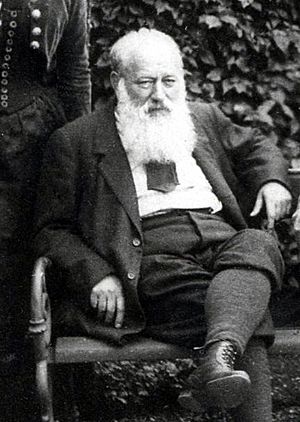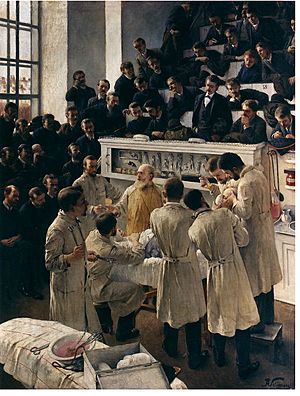Theodor Billroth facts for kids
Quick facts for kids
Theodor Billroth
|
|
|---|---|
 |
|
| Born |
Christian Albert Theodor Billroth
26 April 1829 Bergen auf Rügen, Pomerania, Prussia
|
| Died | 6 February 1894 (aged 64) Opatija, Austrian Littoral, Austria-Hungary
|
| Education | University of Greifswald, University of Göttingen, University of Berlin |
| Known for | Being the founding father of modern abdominal surgery First successful gastrectomy for gastric cancer Applying scientific methods to musicality |
| Medical career | |
| Profession | Surgeon |
| Institutions | Surgical hospital and clinic, Zurich University of Zurich Allgemeine Krankenhaus University of Vienna |
| Sub-specialties | Abdominal surgery |
Christian Albert Theodor Billroth (born April 26, 1829 – died February 6, 1894) was a famous German surgeon. He was also a talented amateur musician.
Many people consider him the founder of modern abdominal surgery. This means he pioneered operations on organs inside the belly. As a musician, he was a close friend of the famous composer Johannes Brahms. He also supported music in Vienna and was one of the first to study music scientifically.
Contents
Early Life and Education
Theodor Billroth was born in Bergen auf Rügen, which was part of Prussia at the time. His father, a pastor, died when Theodor was only five years old. He went to school in Greifswald and finished in 1848.
Billroth wasn't always a serious student. He spent more time playing the piano than studying. He was unsure whether to become a musician or a doctor. His mother wanted him to study medicine.
So, he enrolled at the University of Greifswald. But he spent his first term studying music! Luckily, Professor Wilhelm Baum encouraged him to pursue medicine. Billroth then followed Professor Baum to the University of Göttingen. He earned his medical degree from the Frederick William University of Berlin in 1852.
A Career in Surgery
From 1853 to 1860, Billroth worked as an assistant. He was at Bernhard von Langenbeck’s surgical clinic in Berlin. In 1860, he became the head of Clinical Surgery at the University of Zurich. He also directed the surgical hospital there.
His start in Switzerland was a bit slow. In his first semester, he only had ten students. He even said his private practice didn't earn enough for his morning coffee! But his reputation quickly grew. Billroth was a friendly person, attracting many students and trainees.
Students loved his lectures. He helped make the Medical Faculty of Zurich very important. This happened in just a few years, thanks to his hard work.
New Ideas in Surgery
While in Zurich, Billroth wrote an important textbook. It was called Die allgemeine chirurgische Pathologie und Therapie (General Surgical Pathology and Therapy) (1863). He also started a new idea called "audits." This meant publishing all surgical results, good or bad. This led to honest talks about problems and techniques. It helped improve how patients were chosen for surgery.
In 1867, he became a professor of surgery at the University of Vienna. He worked as the chief of the Second Surgical Clinic. This was at the Allgemeine Krankenhaus (Vienna General Hospital). He became a very powerful figure in the world of surgery there.
During the Franco-Prussian War, Billroth worked in military hospitals. He treated many serious injuries from the battlefield. He wrote about his experiences in Surgical Letters from Mannheim and Weissenburg. The horrors of war made him a strong supporter of peace. He gave a speech in 1891 about caring for wounded soldiers. This speech led to a lot of money being given to help the wounded.
Fighting Infections
Billroth didn't just perform surgery. He also researched "wound fever." This was a common problem for surgery patients. His research in 1874 showed that bacteria caused it. Billroth quickly started using antiseptic techniques in his surgeries. This greatly reduced the number of patients who got wound fever.
With fewer deadly infections, Billroth focused on new surgeries. He started operating on organs that were once thought impossible to reach.
Pioneering Operations
Billroth was one of the first doctors to wear a "white coat" during surgery. He achieved many important milestones in surgery:
- In 1872, he performed the first esophagectomy. This involved removing part of the esophagus and rejoining it.
- In 1873, he did the first laryngectomy. He completely removed a cancerous voice box.
- He was the first surgeon to remove a rectal cancer. By 1876, he had done 33 such operations.
- By 1881, he made intestinal surgery seem almost normal.
His most famous achievement was the first successful gastrectomy for gastric cancer. On January 29, 1881, he performed this operation on Therese Heller. She lived for almost four more months. This operation is still known as the Billroth I.
Billroth wrote many books and papers, about 140 in total. He also worked on a Textbook of General and Special Surgery (1882). He wrote sections on topics like injuries and diseases of the breast.
Billroth inspired many students, creating the "Billroth School" of surgeons. He paid close attention to all parts of his job. This included research, teaching, and even nursing. He believed that science and art were connected. He also trusted his own ability to make changes.
He helped create the first modern way of thinking about surgery. He had new ideas for surgical training. He suggested a long training period after medical school. This included working in hospitals and practicing on cadavers and animals. Then, doctors would spend 2-3 years as assistants. They would study surgical literature and learn advanced skills. Famous surgeons like Alexander von Winiwarter and Jan Mikulicz-Radecki were his students. William Halsted's famous surgical training program was influenced by Billroth's methods.
Music and Science
Billroth was a very talented amateur pianist and violinist. In Zurich, he often played string quartets with professional musicians. In 1865, he met Johannes Brahms, a rising composer. They became close friends after Billroth moved to Vienna in 1867.
Brahms often sent Billroth his music before publishing it. Billroth would give his opinion. He even played in practice sessions for Brahms's chamber music. Brahms dedicated his first two string quartets, Opus 51, to Billroth.
Billroth, Brahms, and music critic Eduard Hanslick were "musical conservatives." They didn't like the new music of Richard Wagner and Franz Liszt. In this musical debate, Billroth supported Brahms. But he was always fair in his comments. He once wrote that "Wagner was indeed a very considerable talent."
Billroth started an essay called "Wer ist musikalisch?" ("Who is musical?"). It was published after he died. This was one of the first times someone tried to study music scientifically. In the essay, Billroth described different types of "amusicality." These included tone deafness and rhythm deafness. This showed that different brain skills are needed to understand music. Billroth died before he could finish his research.
Billroth was excellent at both his job and his hobby. He never saw science and music as separate. He believed they helped each other. He wrote, "It is one of the superficialities of our time to see in science and in art two opposites. Imagination is the mother of both."
Honours and Legacy
In 1887, Billroth became a member of the Austrian Herrenhaus, or "House of Lords." This was a rare honor for a doctor. In 1888, he was elected to the German Academy of Sciences Leopoldina.
See also
 In Spanish: Theodor Billroth para niños
In Spanish: Theodor Billroth para niños


